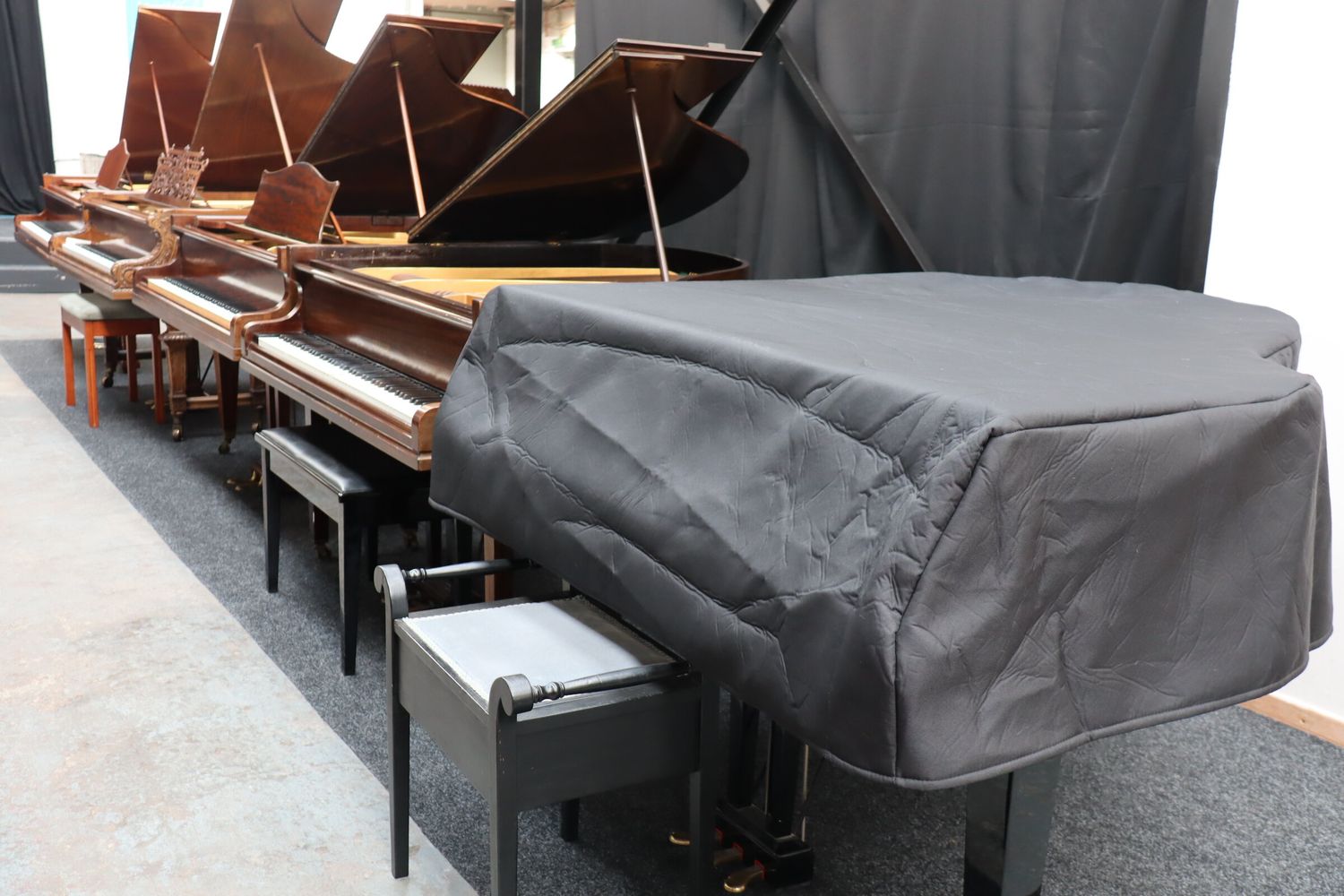Home>Instruments>Piano>How To Make A Melody On Piano


Piano
How To Make A Melody On Piano
Published: February 10, 2024
Learn how to create beautiful melodies on the piano with our step-by-step guide. Discover tips and techniques to enhance your piano playing skills. Perfect for beginners and intermediate players.
(Many of the links in this article redirect to a specific reviewed product. Your purchase of these products through affiliate links helps to generate commission for AudioLover.com, at no extra cost. Learn more)
Table of Contents
**
Introduction
**
Are you looking to create captivating melodies on the piano that resonate with your audience? Crafting a beautiful melody is a skill that can elevate your musical compositions and performances to new heights. Whether you're a budding pianist or an experienced musician, understanding the art of melody creation can unlock a world of musical possibilities.
In this comprehensive guide, we'll delve into the intricacies of crafting mesmerizing melodies on the piano. From understanding the essence of melody to choosing the right chords and infusing variations, we'll explore the key components that contribute to the creation of compelling piano melodies.
Mastering the art of melody creation is not only about technical proficiency but also about infusing emotion and storytelling into your music. Whether you aspire to compose soul-stirring ballads, uplifting anthems, or evocative soundtracks, the principles of melody creation remain fundamental to your musical journey.
Join us as we embark on a melodic adventure, unraveling the secrets of crafting enchanting piano melodies that leave a lasting impression on your listeners. Let's dive into the heart of melody creation and discover the art of weaving musical tales through the expressive language of the piano.
Understanding Melody
Before diving into the process of creating a melody on the piano, it’s essential to grasp the fundamental concept of what a melody represents in the realm of music. A melody serves as the heart of a musical piece, carrying the main theme and capturing the listener’s attention with its memorable and expressive qualities. It is the melodic line that weaves through the harmonies, providing a sense of direction and emotional depth to the composition.
At its core, a melody is a sequence of notes that unfold rhythmically and melodically, creating a cohesive and memorable musical phrase. It is the primary vehicle for conveying emotion, evoking moods, and leaving a lasting imprint on the listener’s mind. A well-crafted melody has the power to communicate joy, sorrow, nostalgia, or a myriad of other emotions, transcending linguistic barriers to resonate with audiences on a profound level.
When crafting a melody, it’s crucial to consider its contour, rhythm, and phrasing. The contour of a melody refers to the shape of its pitch progression, encompassing the rise and fall of notes that give the melody its distinctive character. Rhythm plays a pivotal role in infusing vitality and momentum into the melody, dictating the timing and duration of each note. Additionally, thoughtful phrasing lends a sense of natural flow and breath to the melody, allowing it to unfold in a compelling and organic manner.
Furthermore, understanding the relationship between melody and harmony is integral to creating harmonically rich and melodically engaging compositions. The interplay between the melody and accompanying harmonies forms the essence of musical expression, offering endless possibilities for evoking diverse emotions and atmospheres.
As we delve deeper into the art of crafting piano melodies, we’ll explore the symbiotic relationship between melody and harmony, uncovering the nuances that contribute to creating impactful and resonant musical narratives.
Choosing the Right Chords
When embarking on the journey of crafting a captivating melody on the piano, the selection of chords forms a cornerstone of the creative process. Chords serve as the harmonic foundation that supports and intertwines with the melody, shaping the overall tonal landscape of the composition. By choosing the right chords, you can infuse depth, emotion, and character into your melodic creations.
Harmonizing a melody involves harmonically aligning the accompanying chords with the notes of the melody, creating a harmonious interplay that elevates the musical narrative. The choice of chords not only influences the mood and atmosphere of the composition but also impacts the emotional resonance that the melody conveys to the listener.
When selecting chords to complement a melody, it’s essential to consider the tonal color, tension, and resolution that each chord imparts. Experimenting with different chord progressions can yield varying emotional nuances, allowing you to tailor the harmonic backdrop to suit the expressive intent of the melody. Whether you seek to evoke a sense of tranquility with gentle, open chords or convey a poignant longing with emotive, dissonant progressions, the harmonic choices play a pivotal role in shaping the melodic journey.
Furthermore, understanding the principles of chord voicing and inversions can enhance the harmonic richness of your compositions. By exploring different voicings and inversions of chords, you can imbue your melodies with lush textures and intriguing harmonic movements, adding depth and complexity to the musical tapestry.
As we venture deeper into the realm of melody creation, we’ll unravel the art of harmonizing melodies with evocative chord progressions, empowering you to sculpt poignant and resonant musical narratives that captivate and enchant your audience.
Creating a Melody Line
Embarking on the journey of crafting a captivating melody on the piano involves the art of sculpting a compelling and evocative melody line that resonates with the listener. A melody line serves as the central thread that weaves through the musical tapestry, leaving an indelible impression and guiding the emotional trajectory of the composition.
When creating a melody line, it’s essential to explore melodic motifs, intervals, and phrasing to imbue the melody with character and expressiveness. Melodic motifs, recurring melodic fragments, can instill a sense of familiarity and thematic cohesion within the composition, enhancing its memorability and emotional impact.
Intervals play a crucial role in shaping the melodic contour, dictating the distance between successive notes and influencing the overall emotional quality of the melody. Whether it’s the uplifting leap of a major sixth or the introspective descent of a minor third, the choice of intervals contributes to the melodic narrative’s expressive depth and evocative power.
Additionally, thoughtful phrasing breathes life into the melody, allowing it to unfold with grace and fluidity. Consider the ebb and flow of the melody, punctuating it with expressive nuances and dynamic shaping to convey a sense of narrative and emotional resonance.
Exploring the use of melodic ornamentation and embellishments can further enrich the melodic tapestry, infusing the melody with flourishes and intricacies that captivate the listener’s ear. From graceful trills and arpeggiated runs to poignant grace notes and expressive vibrato, these embellishments add a layer of sophistication and allure to the melody, elevating its emotive impact.
As we delve deeper into the art of crafting a melody line, we’ll uncover the nuances of melodic construction, empowering you to sculpt enchanting and emotionally resonant melodies that linger in the hearts and minds of your audience.
Adding Variations and Embellishments
Infusing variations and embellishments into a piano melody can elevate its expressiveness and captivate the listener with nuanced musical intricacies. Variations breathe new life into the melody, offering fresh perspectives and evocative reinterpretations that enrich the musical narrative.
Exploring melodic variations involves reimagining the core melody through diverse musical lenses, incorporating subtle alterations in rhythm, phrasing, and ornamentation. By introducing rhythmic variations, such as syncopation or rubato, you can imbue the melody with a sense of spontaneity and dynamic flair, inviting the listener on a captivating rhythmic journey.
Furthermore, experimenting with phrasing variations allows you to imbue the melody with expressive nuances, shaping its narrative arc and imbuing it with a sense of organic fluidity. Embracing melodic ornamentation and embellishments, such as trills, turns, and mordents, can add a touch of virtuosity and emotive depth to the melody, captivating the listener’s imagination and evoking an immersive sonic landscape.
Moreover, exploring harmonic variations and reharmonizations can lend a fresh harmonic perspective to the melody, infusing it with unexpected tonal colors and emotive resonance. By reimagining the accompanying chords and harmonic progressions, you can unveil new dimensions of the melody, enriching its harmonic tapestry and captivating the listener with innovative harmonic explorations.
Additionally, embracing improvisational elements within the melody can imbue it with a sense of spontaneity and creative freedom, allowing for expressive and personalized renditions that reflect the performer’s musical identity. By infusing the melody with improvisational flourishes and embellishments, you can breathe new life into the musical narrative, offering a dynamic and compelling interpretation that resonates with the audience.
As we delve deeper into the realm of variations and embellishments, we’ll unravel the art of infusing piano melodies with captivating nuances and expressive intricacies, empowering you to craft enchanting and emotionally resonant musical narratives that leave an indelible imprint on your listeners.
Conclusion
Crafting captivating melodies on the piano is a deeply enriching and rewarding endeavor that invites musicians to explore the boundless realms of creativity and expression. Throughout this journey, we’ve delved into the essential elements of melodic creation, from understanding the fundamental nature of melody to harmonizing it with evocative chords and infusing it with expressive variations and embellishments.
Mastering the art of melody creation transcends technical proficiency; it is an art form that invites musicians to channel their emotions, experiences, and aspirations into a language that resonates with universal human emotions. A well-crafted melody has the power to evoke joy, nostalgia, longing, and a myriad of other emotions, transcending cultural and linguistic barriers to forge deep connections with listeners.
As you continue on your melodic journey, remember that the essence of a captivating melody lies not only in its technical construction but also in the depth of emotion and storytelling it conveys. Embrace the nuances of melodic expression, experiment with diverse harmonic palettes, and imbue your melodies with personal touches that reflect your musical identity.
Whether you aspire to compose soul-stirring ballads, uplifting anthems, or evocative soundtracks, the art of crafting piano melodies offers a boundless canvas for creative exploration and artistic expression. Embrace the joy of musical storytelling, and let your melodies resonate with the hearts and minds of your audience, leaving an enduring imprint that transcends the confines of time and space.
As you continue to hone your skills and delve deeper into the art of melody creation, may your musical odyssey be filled with inspiration, discovery, and the timeless enchantment of captivating piano melodies.











